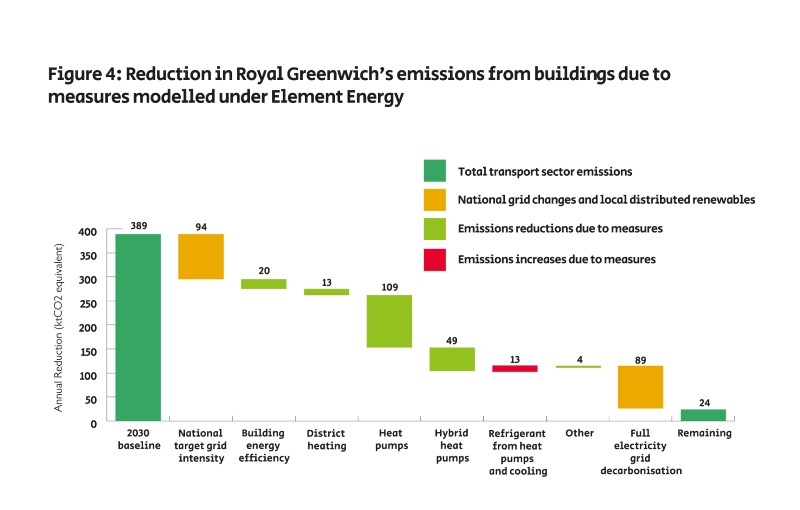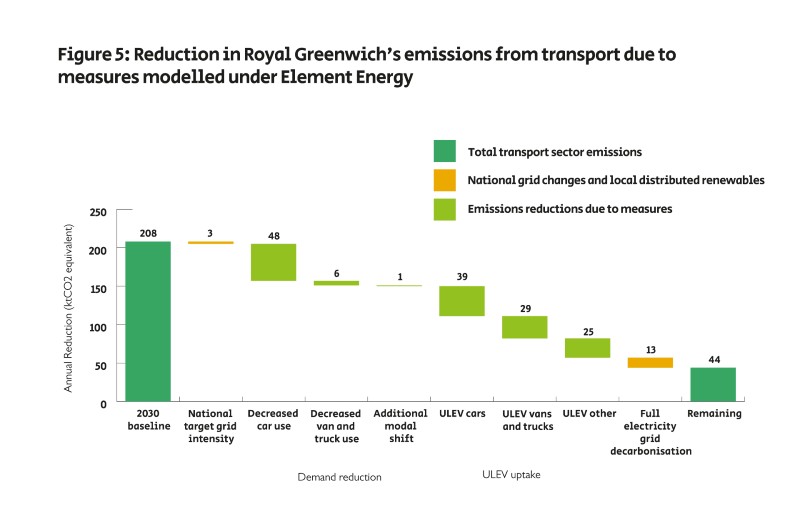Monitoring
An annual monitoring report will be produced reflecting our progress in implementing the Carbon Neutral Plan’s action plan. Progress on each individual action will be monitored against targets and milestones. Where data on emissions reductions achieved through an action is unavailable, we will report activity-related data and qualitative performance information and continue to look for efficient ways to improve data quality.
Our monitoring reports will also refer to the scale of progress against emissions trajectories towards carbon neutrality (see below) and new actions emerging. We will also evaluate the scale and nature of the key gaps between our progress and what is required to be carbon neutral in 2030 – an evaluation that will also inform the evolution of the Carbon Neutral Plan.
Emissions trajectories
The background data and trajectories described in this section will help to guide our monitoring and reporting on progress towards our 2030 target:
In order to inform the development of this action plan, Element Energy undertook bespoke modelling of projected emissions from the borough under a Baseline scenario, and a Maximum Ambition scenario, in which highly ambitious measures were assumed to achieve the scale of rapid emissions reductions implied by a 2030 carbon neutral ambition. The Evidence Base report provides a full explanation of the assumptions modelled, which includes the following (note that these are modelling assumptions and not commitments):
- Energy efficiency – Retrofits on 41% of existing domestic buildings to take the proportion of homes which are EPC (Energy Performance Certificate) C-rated or higher in the borough to 58%.
- Heat networks – Heat networks supply 8% of total domestic heat and 11% of non-domestic. Fossil fuel power for heat networks is entirely phased out by 2030.
- Low carbon heating systems – phase out the use of gas boilers by 2030 except where used (sparingly, and only at times of peak demand) in conjunction with an electric heat pump in a hybrid system. Install heat pumps in 70,000 existing homes and 20,000 new build homes. Install hybrid heat pumps in a further 20,000 existing homes.
- Reduction in car use – car vehicle km travelled in the borough by residents and visitors must decrease by 45% compared to 2015; likely the upper limit achievable through available measures.
- Reduction in van and truck use – vehicle km travelled by vans and trucks must decrease by 10% compared to the Baseline, requiring both modal shift and action to counteract projected increases in goods traffic.
- ULEV uptake – an acceleration of uptake by 10 years compared to the current London-wide 2050 target. Just over half of cars, more than two-thirds of vans and all buses must be zero emission. Over a third of cars, a quarter of vans, two-thirds of trucks and nearly all taxis must be zero emission capable.
The scenario modelling revealed the technical changes with the greatest potential for emissions reductions, as shown in the waterfall charts.


As well as the modelling carried out by Element Energy, the borough’s action can also be informed by the carbon budgets and recommended emissions pathway produced by the Tyndall Centre for Climate Change Research, at the University of Manchester. The Tyndall Centre allocates a cumulative emissions budget to the United Kingdom based on the “well below 2°C and pursuing 1.5°C” global temperature target and equity principles in the United Nations' Paris Climate Change Agreement. Royal Greenwich’s share of this budget is then calculated based on the borough’s historical emissions.
The Tyndall Centre’s report concludes that for Royal Greenwich to make a ‘fair’ contribution towards the Paris Climate Change Agreement, it should
- restrict carbon dioxide emissions from energy use to a maximum cumulative budget of 5.3 million tonnes (MtCO2) for the period of 2020 to 2100
- begin reducing emissions immediately at a rate of approximately 12.5% per year, dependent on national and regional action
- become close to carbon neutral by 2043 (but note that our target is for 2030).
Such targets require rapid and ambitious action – Element Energy's emissions modelling found that this total cumulative budget for energy related emissions is exceeded in 2027 under its Baseline scenario.
The Tyndall Centre’s recommended carbon budget for the period 2028-2032 is 900 kilo-tonnes of CO2, implying an annual budget of approximately 180 kilo-tonnes by 2030. This is similar to, but slightly below, Element Energy’s modelled ‘Maximum Ambition’ scenario, in which the borough’s emissions are reduced to 198 kilo-tonnes by 2030. The Tyndall Centre’s budgets therefore imply the need for highly ambitious change, building on and going well beyond the actions outlined in this plan.